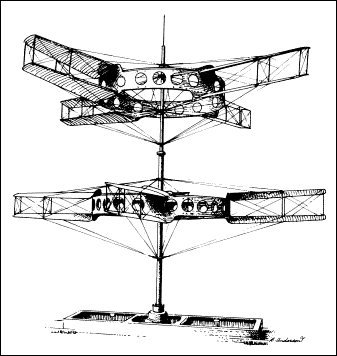The concept of a vertical aircraft or helicopter began to challenge the imagination of Austro-Hungarian scientists toward the end of the 19th century. Noteworthy are the investigations of Josef Popper-Lynkeus, Anton Jarolimek, Professor Georg Wellner, and Wilhelm Kress. In 1894, Wellner experimented with a rotating-wing model that achieved a lift coefficient of 15kg per horsepower. Kress built a small 33kg model with counter-rotating propellers powered by an electric motor. In 1895 his associate. Dr. Waechter, successfully demonstrated the model indoors and out to the Technical Military Committee. Subsequently, Kress proposed a man-carrying helicopter weighing 325kg driven by a 20hp engine. From these rough beginnings, ideas were generated that would find their realization in time of war.
Major Stephan Petroczy von Petrocz, the commander of the Lehr Bataillon in Wiener-Neustadt, conceived the idea of replacing the hydrogen-filled observation balloon by a motor-driven helicopter. To this end, in April 1916, he met with Austro-Daimler director and chief engineer Ferdinand Porsche, several of his assistants, and Oeffag director Karl Ockermüller and Diplom-lngenieur Karl Balaban to discuss the feasibility of building such an aircraft. The result was that Petroczy submitted a proposal to the LFT command on 28 April 1916, calling for development of a captive (tethered) helicopter for use as a static observation platform. The advantages cited were: less danger of fire, less conspicuous and smaller target while aloft, increased operational readiness, elimination of expensive hydrogen generating equipment, and fewer ground-handling personnel required. The belief that, compared to a balloon, the tethered helicopter was more resistant to wind shear was an optimistic dream.
Power was to be supplied by a 300hp electro-motor that Daimler was developing for aircraft use. The war ministry approved the project on 5 May 1916. Oeffag was funded to build several experimental, rotating test rigs and to investigate the operating parameters of large-diameter airscrews or rotors. It soon became apparent that the key to success lay in developing a high-efficiency airscrew. The best available had an efficiency of 61%, whereas 90% or better was required. Balaban moved to Fischamend to work with Leutnant Oskar von Asboth in Professor Knoller's propeller test facility. The result was the perfection of large helicopter rotors up to 8m in diameter using the highest quality mahogany and yielding a 90-95% efficiency.
Eager to proceed, the Fliegerarsenal (Flars) issued specifications calling for a tethered helicopter carrying one observer and a large parachute for the entire aircraft. An operating altitude of 500 to 1000m in wind conditions up to 14 knots was required. The empty weight was estimated at 580kg, plus the weight of the tethering cable (1000m at 150 kg) and the vertical wind component on the cable (230kg) brought the total weight to 960kg. With an estimated lifting force of 1200kg, the reserve lift of 240kg was deemed sufficient for one machine gun, camera, and telephone. Writing in 1922, Balaban felt that such rigid specifications hampered development. It would have been wiser to complete the propeller-rotor development and experiment with flying models first and then write the specification based on experience. At the time the helicopter work was beginning to bear fruit, Petroczy was promoted to command Flars (mid-1917), enabling him to divert additional funds into his pet project. He proposed building two manned, and two smaller, unmanned helicopters of different configuration.
Peter Grosz "Austro-Hungarian Army Aircraft of World War I", 2002
Warning: mysqli_connect(): php_network_getaddresses: getaddrinfo for mysql5.zone.ee failed: Name or service not known in /data03/virt15346/domeenid/www.aviastar.org/htdocs/helicopters_eng/oeffag.php on line 60
Fatal error: Uncaught mysqli_sql_exception: php_network_getaddresses: getaddrinfo for mysql5.zone.ee failed: Name or service not known in /data03/virt15346/domeenid/www.aviastar.org/htdocs/helicopters_eng/oeffag.php:60
Stack trace:
#0 /data03/virt15346/domeenid/www.aviastar.org/htdocs/helicopters_eng/oeffag.php(60): mysqli_connect('mysql5.zone.ee', 'd14657sa18989', Object(SensitiveParameterValue))
#1 {main}
thrown in /data03/virt15346/domeenid/www.aviastar.org/htdocs/helicopters_eng/oeffag.php on line 60





